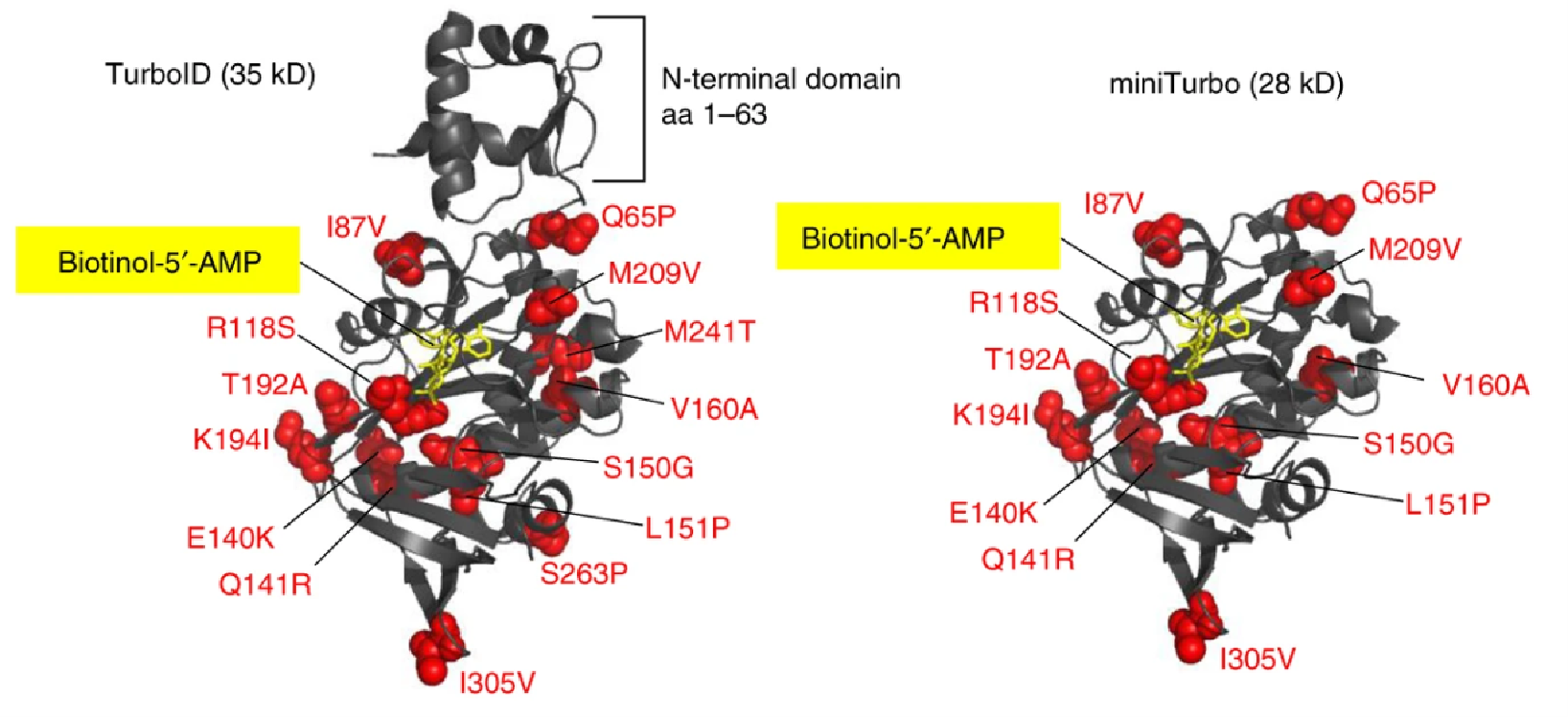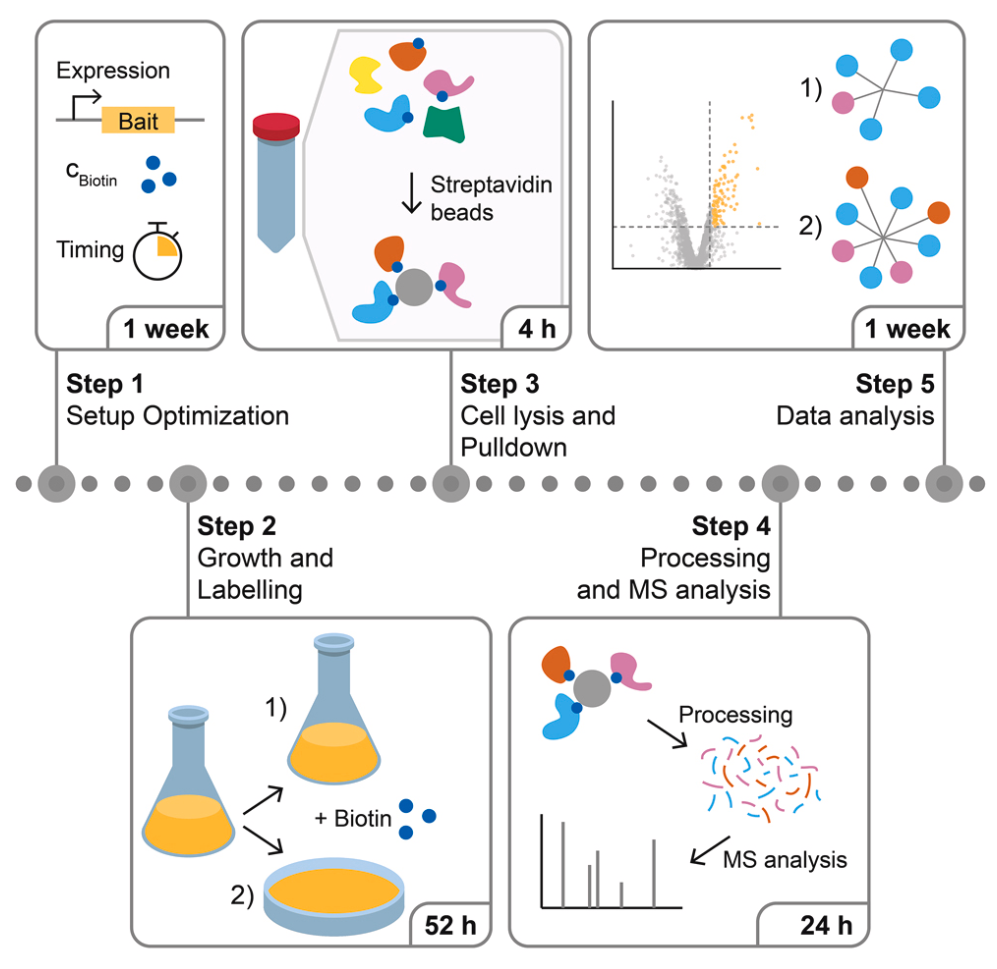miniTurbo Proximity Labeling Analysis Service
- Protein-Protein Interaction (PPI) Mapping
- Post-Translational Modification (PTM) Analysis
- Protein Complex Identification
- Signal Transduction Pathway Analysis
- Drug Discovery and Biomarker Identification
- Study of Dynamic Protein Networks
The miniTurbo proximity labeling is a refined technique used to map protein-protein interactions and study protein networks in living cells. The miniTurbo proximity labeling method is based on the TurboID technology, which uses a small engineered biotin ligase, miniTurbo, to catalyze the biotinylation of proteins in close proximity to a target protein. Like TurboID, miniTurbo offers high efficiency in labeling proximal proteins but with a smaller size, which provides enhanced tissue penetration and reduced potential interference. The biotinylated proteins can then be captured using affinity purification and identified through mass spectrometry, enabling the exploration of complex protein interactions and cellular processes.

Figure 1. E. coli Biotin Ligase Structure (PDB: 2EWN) with Sites Mutated in TurboID (left) and miniTurbo (right) Shown in Red
The miniTurbo Proximity Labeling Analysis Service provides an advanced tool to investigate protein-protein interactions (PPIs), cellular signaling pathways, and protein networks with high specificity. The miniTurbo Proximity Labeling Analysis Service is particularly useful for identifying transient or weak interactions that may be overlooked by other methods, making it ideal for applications in drug discovery, biomarker identification, and systems biology.
Service at MtoZ Biolabs
Analysis Workflow
1. Setup Optimization
The first step of miniTurbo Proximity Labeling Analysis Service involves setting up and optimizing the experimental conditions, including the expression of the bait protein and optimization of the labeling conditions. During this phase, the miniTurbo enzyme is engineered for efficient biotinylation of proteins in close proximity to the bait, ensuring accurate labeling during subsequent steps.
2. Growth and Labeling
Cells are cultured and incubated with biotin for miniTurbo-mediated proximity labeling. The biotinylation process tags proteins near the target protein with biotin, allowing for their subsequent capture.
3. Cell Lysis and Pulldown
After labeling, cells undergo lysis, and the biotinylated proteins are isolated using streptavidin beads. The streptavidin beads efficiently capture biotinylated proteins, enriching for those in proximity to the bait protein, which are then ready for mass spectrometry analysis.
4. Processing and MS Analysis
The captured proteins are processed, digested into peptides, and analyzed by mass spectrometry (MS) or other analytical techniques.
5. Data Analysis
The final step of miniTurbo Proximity Labeling Analysis Service is data analysis to identify interacting proteins. The use of miniTurbo ensures high specificity in the labeling process, allowing for the accurate identification, quantification, and detailed characterization of the proteins interacting with the bait, providing valuable insights into protein networks and interactions.

Figure 2. Workflow for miniTurbo Proximity Labeling Analysis Service
Service Advantages
1. High Specificity: The miniTurbo Proximity Labeling Analysis Service uses the miniTurbo enzyme for highly specific biotinylation of proteins near the target, minimizing background noise and enabling detection of weak or transient interactions.
2. Comprehensive Network Analysis: The miniTurbo Proximity Labeling Analysis Service enables the identification of complex protein interaction networks, offering valuable insights into cellular processes and disease mechanisms.
3. Low Sample Requirements: The miniTurbo Proximity Labeling Analysis Service requires minimal sample amounts, making it ideal for studies with limited biological material.
4. Customizable Workflow: MtoZ Biolabs tailors the workflow to meet specific research needs, ensuring flexible and targeted analysis.
Applications
The miniTurbo Proximity Labeling Analysis Service enables a wide range of applications, including:
Deliverables
1. Comprehensive Experimental Details
2. Materials, Instruments, and Methods
3. Total Ion Chromatogram & Quality Control Assessment
4. Data Analysis, Preprocessing, and Estimation
5. Bioinformatics Analysis
6. Raw Data Files
For more information about our miniTurbo Proximity Labeling Analysis Service, please contact us.
How to order?







